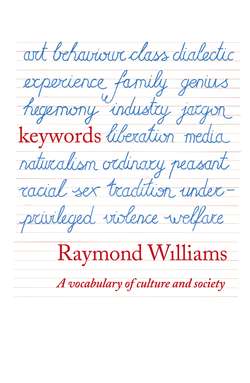Читать книгу Keywords: A Vocabulary of Culture and Society - Raymond Williams - Страница 37
CREATIVE
ОглавлениеCreative in modern English has a general sense of original and innovating, and an associated special sense of productive. It is also used to distinguish certain kinds of work, as in creative writing, the creative arts. It is interesting to see how this now commonplace but still, on reflection, surprising word came to be used, and how this relates to some of its current difficulties.
Create came into English from the stem of the past participle of rw creare, L – make or produce. This inherent relation to the sense of something having been made, and thus to a past event, was exact, for the word was mainly used in the precise context of the original divine creation of the world: creation itself, and creature, have the same root stem. Moreover, within that system of belief, as Augustine insisted, ‘creatura non potest creare’ – the ‘creature’ – who has been created – cannot himself create. This context remained decisive until at least C16, and the extension of the word to indicate present or future making – that is to say a kind of making by men – is part of the major transformation of thought which we now describe as the humanism of the Renaissance. ‘There are two creators,’ wrote Torquato Tasso (1544–95), ‘God and the poet.’ This sense of human creation, specifically in works of the imagination, is the decisive source of the modern meaning. In his Apologie for Poetrie, Philip Sidney (1554–86) saw God as having made Nature but having also made man in his own likeness, giving him the capacity ‘with the force of a divine breath’ to imagine and make things beyond Nature.
Yet use of the word remained difficult, because of the original context. Donne referred to poetry as a ‘counterfeit Creation’, where counterfeit does not have to be taken in its strongest sense of false but where the old sense of art as imitation is certainly present. Several uses of create and creation, in Elizabethan writers, are pejorative:
Or art thou but
A Dagger of the Mind, a false Creation,
Proceeding from the heat-oppressed Brain. (Macbeth)
This is the very coinage of your Brain:
This bodiless Creation extasie
Is very cunning in. (Hamlet)
Are you a God? Would you create me new? (Comedy of Errors)
Translated thus from poor creature to a creator; for now must I create intolerable sort of lies. (Every Man in his Humour)
Indeed the clearest extension of create, without unfavourable implications, was to social rank, given by the authority of the monarch: ‘the King’s Grace created him Duke’ (1495); ‘I create you Companions to our person’ (Cymbeline). This is still not quite human making.
By lC17, however, both create and creation can be found commonly in a modern sense, and during C18 each word acquired a conscious association with ART (q.v.), a word which was itself changing in a complementary direction. It was in relation to this, in Cl8, that creative was coined. Since the word evidently denotes a faculty, it had to wait on general acceptance of create and creation as human actions, without necessary reference to a past divine event. By 1815 Wordsworth could write confidently to the painter Haydon: ‘High is our calling, friend, Creative Art.’ This runs back to the earliest specific reference I have come across: ‘companion of the Muse, Creative Power, Imagination’ (Mallet, 1728). (There is an earlier use of creative in Cudworth, 1678, but in a sentence still partly carrying the older sense: ‘this Divine, miraculous, creative power’.) The decisive development was the conscious and then conventional association of creative with art and thought. By eC19 it was conscious and powerful; by mC19 conventional. Creativity, a general name for the faculty, followed in C20.
This is clearly an important and significant history, and in its emphasis on human capacity the term has become steadily more important. But there is one obvious difficulty. The word puts a necessary stress on originality and innovation, and when we remember the history we can see that these are not trivial claims. Indeed we try to clarify this by distinguishing between innovation and novelty, though novelty has both serious and trivial senses. The difficulty arises when a word once intended, and often still intended, to embody a high and serious claim, becomes so conventional, as a description of certain general kinds of activity, that it is applied to practices for which, in the absence of the convention, nobody would think of making such claims. Thus any imitative or stereotyped literary work can be called, by convention, creative writing, and advertising copywriters officially describe themselves as creative. Given the large elements of simple IDEOLOGICAL and HEGEMONIC (qq.v.) reproduction in most of the written and visual arts, a description of everything of this kind as creative can be confusing and at times seriously misleading. Moreover, to the extent that creative becomes a cant word, it becomes difficult to think clearly about the emphasis which the word was intended to establish: on human making and innovation. The difficulty cannot be separated from the related difficulty of the senses of imagination, which can move towards dreaming and fantasy, with no necessary connection with the specific practices that are called imaginative or creative arts, or, on the other hand, towards extension, innovation and foresight, which not only have practical implications and effects but can be tangible in some creative activities and works. The difficulty is especially apparent when creative is extended, rightly in terms of the historical development, to activities in thought, language and social practice in which the specialized sense of imagination is not a necessary term. Yet such difficulties are inevitable when we realize the necessary magnitude and complexity of the interpretation of human activity which creative now so indispensably embodies.
See ART, IMAGE, FICTION
